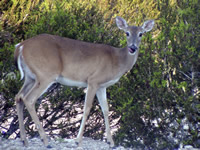
Deer Emerge Hungry in The Spring
After a long cold winter the spring thaw is a warm and welcome sight for most creatures. Melting snow runs off the ground and into streams and lakes to reveal hidden treasures such as mosses and fungi that appear to amazingly have remained green and plump under their winter white blanket. Deer are drawn to these first harbingers of spring happy for the easy access created by the snowmelt.
As the season progresses so does the availability and options for what deer eat in spring. Natural areas provide wondrous variety of greens and flowers that deer find acceptable in their diets. Pretty flowering shrubs often get hit the hardest. Some of the favorites among what deer like to eat in the spring include azalea, hydrangea, trumpet vine and honeysuckle. Other popular shrubs include grape vines, blueberry and dogwood.
Farmers may find deer are attracted to their cover crops including winter wheat and rye grass but flowers make up the bulk of the spring diet. Deer will munch on spring flowering beauties including violet and wild strawberry. Near wetter areas they will find trefoil, trout lily and jewelweed growing abundantly. In bright and sunny areas deer will feast on dandelions, spiderworts and fleabane.
With an average appetite budget ranging from 5 – 9 pounds per day deer are not always that particular about the quality of the food they eat. They will eat woody parts of trees and shrubs even though the nutritional value is next to nothing. In the spring deer will eat the buds and twigs of several deciduous trees including maples, elms and willows.
Deer will not hesitate to venture out of the woods, through the fields and into neighborhoods. Home gardeners can attest that deer regularly dine on spring flowering bulbs. Their favorite flowering bulbs include tulips, crocuses and daffodils. Deer will eat the green shoots as they pop up from the ground and the beautiful flowers just as they begin blooming, much to the dismay of the gardener in residence.
After a long cold winter with a diet consisting mainly of nutrient deficient twigs and bark, lush flower gardens are often the hardest hit. And supporting a 5 – 9 pound daily intake requirement with plant material means that the quantities of food needed is high. A hungry animal will not hesitate to venture into yards and gardens to satisfy their hunger. Natural areas, farmer’s fields and back yard gardens combine to assist in providing the foods that deer eat in the spring.







